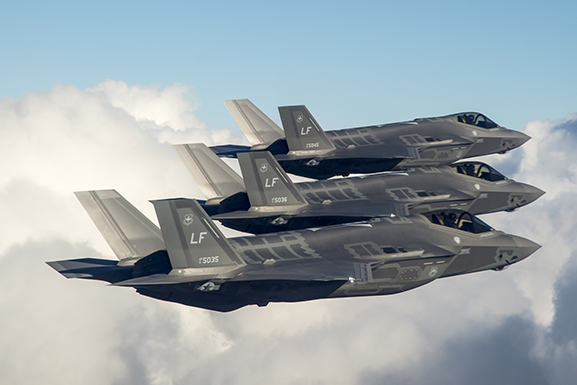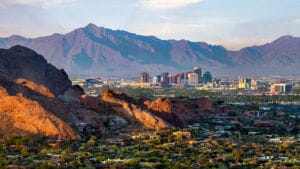At any given time, a Glendale or Goodyear resident may be able to look out their window and see fighter jets fly over their yard. Now, the West Valley is opening that window to the world.
“(Luke) is a window to the world,” says Joe LaRue, executive vice president of Sun Health. “Every year, hundreds of folks cycle through Luke working, training and learning.”
Luke Air Force Base is located seven miles from Glendale’s business district. However, when you’re in an F-35 Lightning II that can go 1,200 miles per hour those lines blur fast.
Luke has been training humans to harness the power of steel birds in the West Valley since 1941, when the base opened during World War II. It has since hosted thousands of pilots, as LaRue said, from all over the world, in what has become the largest fighter pilot training base in the Air Force. Luke’s pilot training mission’s bread and butter is the Barry M. Goldwater Air Force Range, which is 1.8 million acres (that’s nearly the size of New Jersey).
Luke may be host of the most influential Air Force bases in the world, but its wingspan stretches beyond its gates to the cities of the West Valley.
It’s estimated by Maguire Company that Luke has an annual statewide economic impact of more than $2 billion.
Community impact
However, to economic developers in the West Valley, its influence is priceless.
Ten years ago, the Fighter Country Foundation was formed to support Luke Air Force Base’s military families. Five years ago, West Valley Partners and Fighter Country Partnership launched the Luke Forward campaign to bring the F-35 fighter pilot training program to the base. The 13 cities of the West Valley came together with a common goal.
“That probably is the most profound result of (Luke),” says Goodyear Mayor Georgia Lord. “It made those 13 cities become cooperative and collaborative. They all had the same goal, direction. I don’t know what could have replaced that to bring the cities together.”
The camaraderie model developed over Luke is translating into other obstacles for the West Valley.
“The way the cities and private sector are able to come together to support Luke, they use that model to support other things like water issues,” says Michelle Lawrie, economic development director for Goodyear and former CEO and President of WESTMARC. “I’m a big believer in regionalism. A lot of those problems won’t be solved by cities themselves, and using that model to apply that relationship to other issues, we call it ‘cooper-tition.’”
The West Valley cities work closely with Luke and communication flows freely at quarterly breakfasts.
“It’s the rallying point that the West Valley has in terms of civic pride,” Lawrie says. “It’s a neutral area where all the cities can get together and support Luke…It’s in everything we do. Everything we work toward in terms of what we’re trying to leverage in the West Valley.”
Regional gem
Even though the base is technically within Glendale’s city limits, no one thinks about that, says Lawrie. “It’s just ‘the West Valley,’ it transcends those boundaries.”
“The West Valley’s DNA is imprinted with the Luke mission,” says Bill Sheldon, interim president and CEO of WESTMARC. “Many of the cities would not have enjoyed the economic contributions and stability the base has brought as well as the galvanizing effect the shared mission brings.”
He credits much of this to former Glendale mayor Elaine Scruggs.
“Elaine Scruggs was very instrumental in rallying support and awareness around Luke and Luke Forward,” he says. “Many of us who might have remained on the sidelines wrote strong letters of support and helped get the word out through co-workers and other organizations we belong to. Mayor Scruggs certainly deserves high praise for her foresight and dauntless campaigning on this issue.”
If there’s one point the West Valley’s partnerships illustrate, it’s that it takes a village to make a village.
Something people outside of the West Valley don’t understand about Luke, Lord says, is that it’s a small city.
The base population is estimated to be 8,000 military and Department of Defense civilian employees as well as 6,700 family members. Add in the 70,000 retired military members living in the metropolitan area — and the 4,900 more who come down during “snow-bird” season — and you’re looking at an estimated support base for 85,000 to 133,000.
“The activity of the base and its current and retired employees have brought sustainable economic impact to the West Valley for decades,” says Sheldon. “This stability helped put in place the ability for communities of the West Valley to grow into some of the largest cities in the state of Arizona.”
Economic engine
To put those numbers in perspective, the top employers in the West Valley, according to Maricopa Association of Governments, are Walmart (3,329 employees), Banner Health (2,876 employees) and Peoria Unified School District (2,265 employees).
“Luke is able to spur development,” says Lawrie, who points to Prime Solutions Group — an aerospace and defense consulting contractor and, more relatively, a spinoff for former Lockheed Martin employees who are making livings despite the sequestration. The company has grown from five to 17 people since receiving two grants in the last three years.
“Lockheed Martin left a foundation to build upon,” Marvin said in a press release about his Air Force grant awarded in July. “Now we have the opportunity to extend the heritage at the Phoenix-Goodyear Airport from sensor integration to new horizons of Sensor Networks of Sensors. Lockheed has been very helpful and supported PSG as an industry sponsor on the recent innovative research award from the Air Force.”
Goodyear hosts 93 percent of the high-noise contour areas around the Southern Departure Corridor, where Luke pilots fly. Though many residents will tell you the noise doesn’t bother them, Goodyear was aggressive about its approach to buffering the area surrounding this portion of the base in order to keep development from encroaching.
“I think we’ve done very well with the planning and zoning,” Lord says. The city purchased Duncan Farms, a working farm that hosted popular tours on the land over which pilots were flying, to begin taking care of the noise problem.
“We were taking away an area people enjoyed having, but they hung with us and knew the importance of this.”
The nearby Westgate Entertainment District alleviates some of that pressure.
“A day doesn’t go by that we don’t see numerous service men and women from Luke eating at, shopping and going to the movies at Westgate,” says Jeff Teetsel, development manager at Westgate. “As the most convenient and significant entertainment destination near Luke, Westgate embraces its role as a place for military members and their families to unwind and have a good time.”
Roots deepening
Luke and Westgate have recently become more intertwined with the base’s decision to build a 3,050-square-foot recruitment center that will open this year.
“That will strengthen the tie and traffic between Luke and Westgate,” he adds.
Those jobs, brought to the region by Luke, are paramount to the areas future, says LaRue.
“The West Valley lacks jobs, jobs that pay and jobs that need folks with leading-edge technology, education and training,” he says. “LAFB employs thousands who live, work and play in the West Valley. Some of those folks choose to remain in the Phoenix area, others move on and then return in future years because of the positive time spent in the area. Luke is a great way for folks to get to know Arizona and decide that it is the place for them. Many of the folks that decide to stay and return are highly educated and trained and improve the overall demographic characteristics of our region.”
Even if Luke hadn’t existed, Lord says the West Valley would have still grown albeit slowly.
“The nature of where we are west of Phoenix with the housing market, the job market and the land, we have a great advantage out here,” she says. “We have the most land mass yet to be developed. As Phoenix grows, it’s natural that people are going to go east or west. West has more land opportunity. It would have developed.”
With a massive canvas to fill with development, Luke is no longer alone.
“The West Valley communities are becoming even more purposeful in their engagement with Luke and are better positioned to utilize the tremendous talent produced by the base for private sector growth and employment opportunities,” Sheldon says.
As it has been for the last 75 years, the sky’s the limit for the West Valley. All you have to do is open the window.




